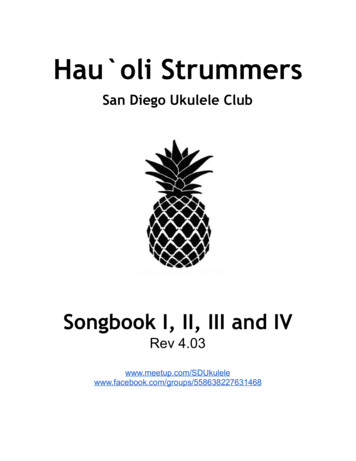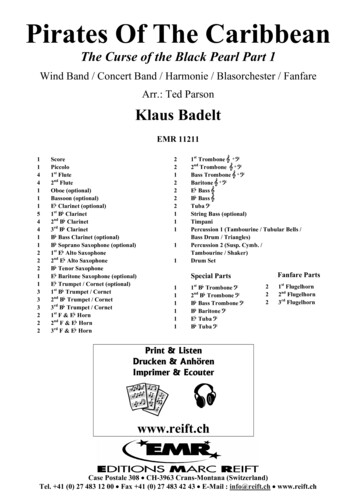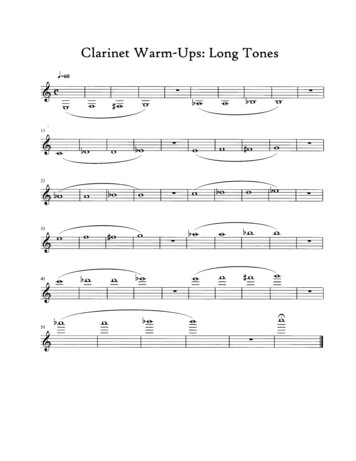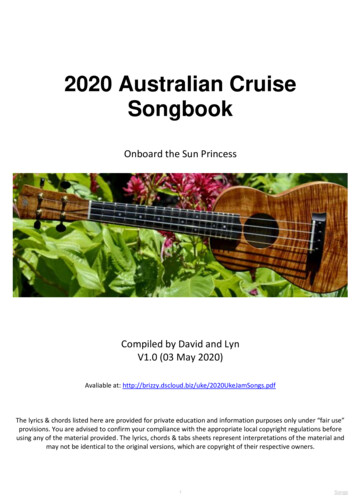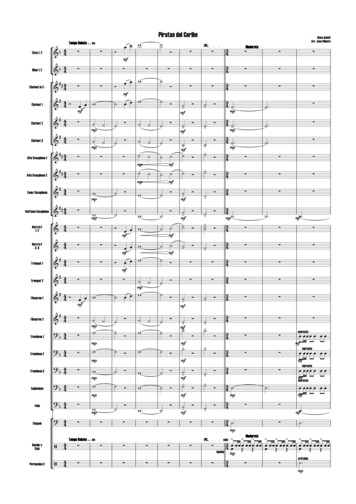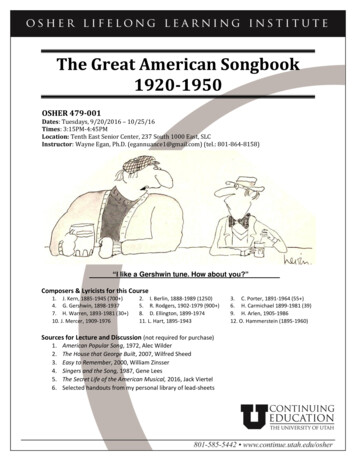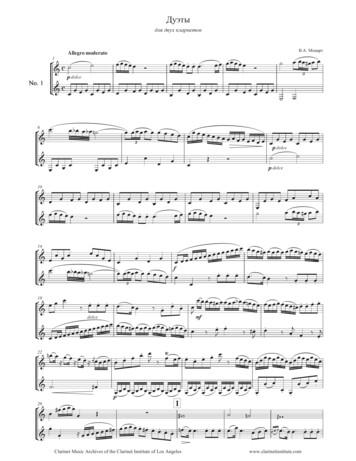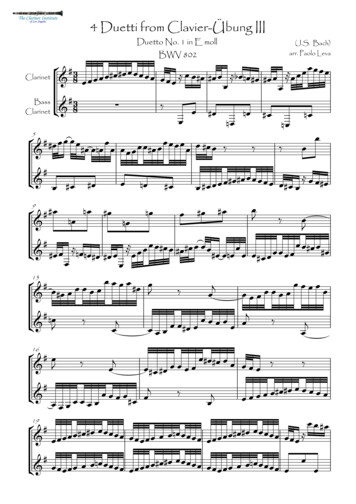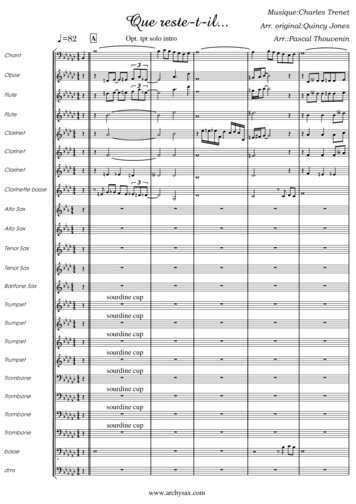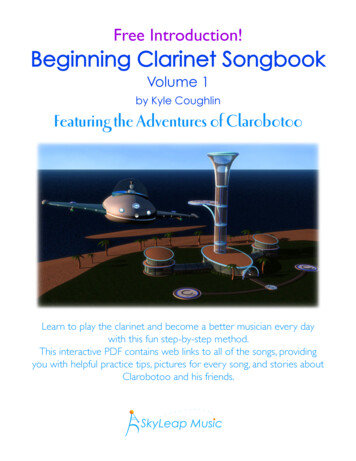
Transcription
Free Introduction!Beginning Clarinet SongbookVolume 1by Kyle CoughlinFeaturing the Adventures of ClarobotooLearn to play the clarinet and become a better musician every daywith this fun step-by-step method.This interactive PDF contains web links to all of the songs, providingyou with helpful practice tips, pictures for every song, and stories aboutClarobotoo and his friends.SkyLeap Music
Beginning Clarinet Songbook, Volume 1, Featuring the Adventures of Clarobotoo 2010 byKyle CoughlinAll Rights ReservedNo part of this book may be reproduced or transmitted in any form or by any means,including photocopying or recording, without written permission from the publisher.Printed in the USASkyLeap MusicFor further information, go to www.SkyLeapMusic.com
Beginning Clarinet Songbook, Volume 1Free TrialTable of ContentsThank You4How to Use this Book5Introduction6Acknowledgments7Lesson 1 - Melody - Phrases and Breath Marks8Lesson 2 - Rhythm - Ties, Half Notes, and Half Rests13Lesson 3 - Sound - New Pitches: F, G, and A18Lesson 4 - Rhythm - Dotted Half Notes, Whole Notes, and Whole Rests23Lesson 5 - Sound - Dynamics: forte and piano28End Notes - How to Buy the Book33About the Author34Appendix - Simple Steps for Learning a New Piece of Music35
4Welcome to the Clarinet!Thank you for trying out the Beginning Clarinet Songbook. I hope you find the bookhelpful and I hope you enjoy playing through all of the songs. Please visit thebook’s website for much more information on the clarinet and how to play it.Clarobotoo, Flopsy the Whimsical Clown, and Klara Nett are all there to help youon your journey to become a better musician every day.Once you have completed the free introductory lessons please visit the websiteto purchase the rest of the book.Thank you,Kyle Coughlinwww.ClarinetSongbook.com
5How to Use this BookThis Free Trial PDF version of Beginning Clarinet Songbook is not just a book, it is aninteractive instructional manual. Every song in the book has its own web page. Ifyou are connected to the internet, simply click on the title of any song in the bookand you will be directed to the corresponding web page. Each web page hashelpful suggestions and reminders on how to learn the piece, links to othereducational tools like MetronomeBot, and a picture (or two) related to the song.Several of the songs have stories that accompany them. You can also learn allabout Clarobotoo and his adventures by following the links to the SkyLeap Musicwebsite.The title page of each lesson also links to the book’s website. Each lesson has anintroduction with thorough explanations of the new topic that you are studying.Be sure to visit these pages to learn the details on each new aspect of playing theclarinet.Practice carefully and accurately and Have Fun!www.ClarinetSongbook.com
6IntroductionWelcome to the Free Trial of the Beginning Clarinet Songbook by Dr. Kyle Coughlin. Thisbook will help you learn how to play the clarinet, and it will help you to become a bettermusician. Please read through this introduction and go to www.ClarinetSongbook.com beforeyou begin the lessons in this book. The Introductions on the website will get you started withtone production and the basics of rhythm.Beginning Clarinet Songbook takes a “Sormelharf” approach to learning music.Sormelharf is a word created by Dr. Coughlin that represents five basic elements of music:sound, rhythm, melody, harmony, and form. For more information on Sormelharf, go towww.sormelharf.com.The book is divided into individual “lessons,” each focusing on a specific element ofmusic. Every lesson consists of several songs and a few duets. The songs in each lesson getprogressively harder. It is best to work on the music with a private teacher to make sure thatyou are playing correctly. Visit www.ClarinetSongbook.com for helpful practice tips, lots ofpictures, audio recordings, more information on the songs, and a fun, interactive clarinetfingering chart to help you learn the notes on the instrument.Throughout the book and the website, Clarobotoo and Flopsy the Whimsical Clown willhelp you learn each new aspect of playing the clarinet. Follow their lead and you will go a longway!Helpful educational sites from SkyLeap meBot.comwww.Clarobotoo.com
Beginning Clarinet Songbook, by Kyle CoughlinAcknowledgmentsI would like to thank all the great clarinet players who have motivated me to become a betterclarinetist and musician, especially Karl Leister, Eddie Daniels, Mitchell Lurie, Louis Cahuzac, Harold Wright, Ricardo Morales, and my teachers Loren Kitt and Ed Walters. Very special thanksgo to my first clarinet teacher, Ralph Greenblatt, for encouraging me and believing in my potential. I would also like to thank Mike Blackman, whose constant enthusiasm for teaching musichas been a huge inspiration for me.Kyle Coughlin Kyle CoughlinKlara Nett
Beginning Clarinet Songbook, by Kyle CoughlinLesson 1Focus on MelodyPhrases and Breath MarksIntroducing Clarobotoowww.ClarinetSongbook.com
9Beginning Clarinet Songbook, by Kyle CoughlinLesson 1: Focus on MelodyPhrases and Breath MarksA Melody is a group of pitches played to a specific rhythm. A good melody will catch yourear, and when you hum a song you are humming its melody. All of the songs in this book aremelodies. Some melodies are very short and others can be quite long.A phrase is section of a melody. Phrases are like musical sentences with a clear beginningand end. The end of each phrase is indicated with a phrase mark which looks like a comma.The phrase mark is also called a breath mark.Breath mark Breathe Wherever you see the breath mark, you should breathe. Try to breathe only at the placeswhere it is marked, and avoid breathing in the middle of phrases.Even though there is no breath mark at the beginning of each piece, make sure to breathedeeply before you start each melody. 2010 by Kyle Coughlin and SkyLeap Music All Rights Reserved. Unauthorized duplication is prohibited. Please see the Friendly Reminder.
Beginning Clarinet Songbook, by Kyle CoughlinLesson 1: Phrases and Breath Marks10 1 1 12 2122. Introducing Clarobotoo 2 2 2(Breathe) 1 1 12 2 1 11 2 1 2 1 2 3. Klara Nett Plays the Clarinet 4. !e Waltz of "e Lilacs in Ma# 1 2 1. Where to Breathe 2 3 1 2 3 1 2 3 1 2 3 2010 by Kyle Coughlin and SkyLeap Music All Rights Reserved. Unauthorized duplication is prohibited. Please see the Friendly Reminder.
Beginning Clarinet Songbook, by Kyle CoughlinLesson 1: Phrases and Breath Marks 5. The Goat Who Wanted to Have His Clarinet (and eat it, too) 2 34 111 6. The Magic Goldfish 123 4 1234 123 4 Duet Number 1 2010 by Kyle Coughlin and SkyLeap Music All Rights Reserved. Unauthorized duplication is prohibited. Please see the Friendly Reminder.
Beginning Clarinet Songbook, by Kyle CoughlinLesson 1: Phrases and Breath Marks12 Duet Number 2 Duet Number 3 2010 by Kyle Coughlin and SkyLeap Music All Rights Reserved. Unauthorized duplication is prohibited. Please see the Friendly Reminder.
Beginning Clarinet Songbook, by Kyle CoughlinLesson 2Focus on RhythmTies, Half Notes, and Half RestsClarobotoo’s Flying Carwww.ClarinetSongbook.com
14Beginning Clarinet Songbook, by Kyle CoughlinLesson 2: Focus on RhythmTies, Half Notes, and Half RestsThe music in Lesson 1 consisted entirely of quarter notes and quarter rests. In this lessonwe are going to focus on ties and two new rhythmic durations: half notes and halfrests.A tie is a line that connects two or more notes that have the same pitch. 12TieWhen two notes are tied, we hold them together and we do not re-articulate or tonguethe second note. In the above example, we play the tied quarter notes for two beats.The half note is equal to two quarter notes tied together. When the quarter note isequal to one beat, the half note is equal to two beats. 1Half Note 212The half rest is equal to two quarter rests. It looks like a small bar that sits on top of themiddle staff line. In the example below it indicates two beats of silence. 1Half Rest 234 2010 by Kyle Coughlin and SkyLeap Music All Rights Reserved. Unauthorized duplication is prohibited. Please see the Friendly Reminder.
Beginning Clarinet Songbook, by Kyle CoughlinLesson 2: Ties, Half Notes, and Half Rests2 112 2 2 111 1 2112 21 21 212 23434 121 122 3434 1 12 234 43223. Breakfast for the Butterfly 1 2 2 1 12 234344. Introducing Flopsy the Whimsical Clown 111 2. Counting Half Notes 1 2 2 1 1 1 1. The Tie 15 22 3 31 122 3 31 1 2 2 3 3 1 122 33 2010 by Kyle Coughlin and SkyLeap Music All Rights Reserved. Unauthorized duplication is prohibited. Please see the Friendly Reminder.
Beginning Clarinet Songbook, by Kyle CoughlinLesson 2: Ties, Half Notes, and Half Rests165. Fair or Foul 6. Clarobotoo's Flying Car Duet Number 1 2010 by Kyle Coughlin and SkyLeap Music All Rights Reserved. Unauthorized duplication is prohibited. Please see the Friendly Reminder.
Beginning Clarinet Songbook, by Kyle CoughlinLesson 2: Ties, Half Notes, and Half Rests17Duet Number 2 Duet Number 3 2010 by Kyle Coughlin and SkyLeap Music All Rights Reserved. Unauthorized duplication is prohibited. Please see the Friendly Reminder.
Beginning Clarinet Songbook, by Kyle CoughlinLesson 3Focus on SoundNew Pitches: F, G, and AClarobotoo’s Lovely Home by the Seawww.ClarinetSongbook.com
19Beginning Clarinet Songbook, by Kyle CoughlinLesson 3: Focus on SoundNew Pitches: F, G, and AIn this lesson we will learn three new pitches. So far we have played C, D, and E.We will now add F, G, and A. FGA Play the pitch F by covering the thumb hole with your left thumb. To play the pitch G, you donot cover any of the tone holes. The pitch A is produced by using the first finger of your lefthand on the top key on the front of the instrument.For the exact fingering of each pitch remember to visitwww.ClarinetChart.comThe site includes online, interactive fingering charts, as well as printable fingering charts.Since these notes use only one or no fingers, you must support the instrument strongly withyour right thumb under the thumb rest. Also, use a firm embouchure to help keep theinstrument steady.To improve and increase the speed of your response time for each note, go towww.ClarinetSpace.com and play the pitch name games. 2010 by Kyle Coughlin and SkyLeap Music All Rights Reserved. Unauthorized duplication is prohibited. Please see the Friendly Reminder.
Beginning Clarinet Songbook, by Kyle CoughlinLesson 3: New Pitches F, G, and A201. F and G 2. Green Fields in Summer 3. Smoo! Sailin" 4. Klara Nett's Autumn Song 2010 by Kyle Coughlin and SkyLeap Music All Rights Reserved. Unauthorized duplication is prohibited. Please see the Friendly Reminder.
Beginning Clarinet Songbook, by Kyle CoughlinLesson 3: New Pitches F, G, and A5. The Barking Dog Duet 6. Clarobotoo's Lovely Home by the Sea 21 Duet Number 1 2010 by Kyle Coughlin and SkyLeap Music All Rights Reserved. Unauthorized duplication is prohibited. Please see the Friendly Reminder.
Beginning Clarinet Songbook, by Kyle CoughlinLesson 3: New Pitches F, G, and A22 Duet Number 2 Duet Number 3 2010 by Kyle Coughlin and SkyLeap Music All Rights Reserved. Unauthorized duplication is prohibited. Please see the Friendly Reminder.
Beginning Clarinet Songbook, by Kyle CoughlinLesson 4Focus on RhythmDotted Half Notes, Whole Notes, and Whole RestsClarobotoo Practices at His Home Overlooking the Seawww.ClarinetSongbook.com
24Beginning Clarinet Songbook, by Kyle CoughlinLesson 4: Focus on RhythmDotted Half Notes, Whole Notes, and Whole RestsIn the songs of Lesson 4 we will focus on three new note and rest values: dotted halfnotes, whole notes, and whole rests.The dotted half note is equal to three quarter notes tied together. Therefore, when thequarter note is equal to one beat, the dotted half note is equal to three beats.Dotted Half Note 1231 2 3The whole note is equal to four quarter notes tied together. Therefore, when the quarternote is equal to one beat, the whole note is equal to four beats.Whole Note 1 2341 2 34The whole rest looks very similar to the half rest, but it is placed just below the secondline from the top of the staff. The whole rest indicates that the entire measure is silent.Therefore, when there are two beats in a measure, the whole rest represents two beats ofsilence. When there are four beats in a measure, the whole rest represents four beats ofsilence. 2 beats rest 3 beats rest 4 beats restUse the talking metronomes at www.MetronomeBot.com to helpcount your rhythms accurately. 2010 by Kyle Coughlin and SkyLeap Music All Rights Reserved. Unauthorized duplication is prohibited. Please see the Friendly Reminder.
Beginning Clarinet Songbook, by Kyle CoughlinLesson 4: Dotted Half Notes, Whole Notes, and Whole Rests1. !e Orchid's Lullaby 1231 2 3 1 2 3 1231 2 3 123 1 2 3 2 1 2 3 1 2 3 41 1 2 3123 1 2 3 1 2 3 3 1 2 31 2 3 131 2 3 2 123 1231231 2 3 1 2 1234 1 2 3 4 1234 1 2 3 4 1234 1 2 3 43 4. !e Merry Li"le Sandpipe# 3. The Little Blue Elf1 2 3 2. Flopsy the Whimsical Clown Visits a Farm 1 2 3 25 1234 2010 by Kyle Coughlin and SkyLeap Music All Rights Reserved. Unauthorized duplication is prohibited. Please see the Friendly Reminder.
Beginning Clarinet Songbook, by Kyle CoughlinLesson 4: Dotted Half Notes, Whole Notes, and Whole Rests26 5. Clarobotoo Practices at His Home Overlooking the Sea 1 2 3 4 1 2 3 4 1 2 3 41 2 3 4 1 2 3 4 1 2 3 4 1 2 3 4 6. Follow Your Path Duet Number 1 1 2 3 4 2010 by Kyle Coughlin and SkyLeap Music All Rights Reserved. Unauthorized duplication is prohibited. Please see the Friendly Reminder.
Beginning Clarinet Songbook, by Kyle CoughlinLesson 4: Dotted Half Notes, Whole Notes, and Whole Rests27Duet Number 2 Duet Number 3 2010 by Kyle Coughlin and SkyLeap Music All Rights Reserved. Unauthorized duplication is prohibited. Please see the Friendly Reminder.
Beginning Clarinet Songbook, by Kyle CoughlinLesson 5Focus on SoundDynamics: forte and pianoClarobotoo Looks Out on the Sea and Contemplates aLife of Adventurewww.ClarinetSongbook.com
Beginning Clarinet Songbook, by Kyle Coughlin29Lesson 5: Focus on SoundDynamics: forte and pianoThe term dynamics describes how loudly or softly we play music. There are several waysin which we can indicate the dynamics in a piece of music. In this lesson we will start withtwo of the simplest dynamic markings: forte (pronounced for-tay) and piano (pronouncedpee-an-oh, just like the name of the instrument).Forte means loud and is represented in music by the letter ff forte loudPiano means soft or quiet and is represented in music by the letter pp piano softA dynamic marking is placed underneath the staff at the beginning of the section to which itapplies. When you see a forte or piano marking, continue to play at that level until you seeanother dynamic marking that will change it.Remember that these terms only refer to the loudness or softness of your sound. Alwaysbreathe deeply and produce your best possible tone, whether you are playing loudly or softly. 2010 by Kyle Coughlin and SkyLeap Music All Rights Reserved. Unauthorized duplication is prohibited. Please see the Friendly Reminder.
Beginning Clarinet Songbook, by Kyle CoughlinLesson 5: forte and piano30 p p 2. Klara Nett's Winter Song pf f 1. Autumn's Treasure 3. !e Moon, "e Grass, and a Clear Poo# 4. Mrs. Goose Goes for a Swim 2010 by Kyle Coughlin and SkyLeap Music All Rights Reserved. Unauthorized duplication is prohibited. Please see the Friendly Reminder.
Beginning Clarinet Songbook, by Kyle CoughlinLesson 5: forte and piano315. Clarobotoo Looks Out On the Sea and Contemplates a Life of Adventure f p p f f6. Raspberry Jam p Duet Number 1 f f pf pf 2010 by Kyle Coughlin and SkyLeap Music All Rights Reserved. Unauthorized duplication is prohibited. Please see the Friendly Reminder.
Beginning Clarinet Songbook, by Kyle CoughlinLesson 5: forte and piano32 Duet Number 2pp ff f p p Duet Number 3f 2010 by Kyle Coughlin and SkyLeap Music All Rights Reserved. Unauthorized duplication is prohibited. Please see the Friendly Reminder.
I hope you have enjoyed working through the free introductory lessons of theBeginning Clarinet Songbook. If you would like to continue using this method book,you may purchase all of Volume 1 at the book’s website:www.ClarinetSongbook.comTo Become a Better Musician Every Day:Practice well.Practice often.Visit Clarobotoo and say hello!Have Fun!Thank you,Kyle Coughlin
About the AuthorKyle CoughlinClarinetist, Saxophonist, Performer, Educator, Composer, AuthorKyle Coughlin has earned both his Doctorate and Masters degrees in clarinet performance fromthe Peabody Conservatory, as a student of Loren Kitt. He received his Bachelors degree fromthe University of Maryland as a student of Ed Walters.An active and enthusiastic educator, Dr. Coughlin is on the faculty of Howard CommunityCollege in Columbia, Maryland, where he teaches private lessons and an online musicappreciation class. He has also lead the school jazz band, taught jazz improvisation, and musicfundamentals. His former students have gone on to the Eastman School of Music, the PeabodyInstitute, Berklee College of Music, University of Florida, University of Maryland, and TowsonUniversity, among others. He has written several educational books which are published bySkyLeap Music. Dr. Coughlin has won many honors for his compositions, including a grant fromthe Maryland State Arts Council in 2003. His composition credits also include works for FoxTelevision, the Discovery Channel, Maryland Public Television, and several commercial jingles.Dr. Coughlin is an active recitalist and has given numerous performances across the country.His honors include an Individual Artist Award in Solo Performance from the Maryland State ArtsCouncil in 2007, first prize in the Professional Division of the Baltimore Music Club, and finalistin the Buffet North American Clarinet Competition.Dr. Coughlin has released two jazz CDs, When Afternoons Return and In the Shadow of Palms. In2004, he was a featured soloist at ClarinetFest, the annual conference of the InternationalClarinet Association.Over the last several years, Dr. Coughlin has become very involved in computer generated visualart and has worked extensively with Photoshop, Illustrator, Cinema 4D,Vue, Flash, and othergraphics programs. He designed and created every image of Clarobotoo, Flopsy the WhimsicalClown, and Klara Nett, as well as all of the other pictures on the Clarinet Songbook website.He has combined his musical skills with his interest in art and pedagogy to create severalinteractive, educational websites, including www.ClarinetChart.com, www.MetronomeBot.com,www.RhythmBot.com, and www.ClarinetSpace.com.For more information please visit www.KyleCoughlin.com
SkyLeap MusicEducational ToolsSimple Steps for Learning aNew Piece of MusicSuggestions byDr. Kyle Coughlinoooooo1Focus on Sound: Play a medium-long tone on each note of the firstphrase of the piece. A few seconds on each note is fine.2Focus on Rhythm: Clap and count the rhythm of the first phrase.3Focus on Rhythm: Play the rhythm of the first phrase on one pitch.Any pitch will do -- usually the first note of the phrase is a good oneto select. Check your key signature, and make sure that you play the correctpitches. Produce your best possible tone quality. Play the dynamics that are written. Use your metronome and clap and count at a tempo at which you willplay the phrase on your instrument. Think ahead and take it slow! Tap your foot to the beat of the metronome. If the rhythms are complicated, write the names of the beats and thesubdivisions of the beat. Go through this process several times until it is effortless and accurate. Play along with your metronome, at the same tempo that you clappedthe rhythms. Make sure to play the correct dynamics. Tap your foot to the beat of the metronome. Go through this process several times until it is effortless and accurate.4Focus on Melody: Play the rhythm of the first phrase with the writtenpitches. Play along with the metronome, at the same tempo you clapped therhythms. If it is too fast to play the notes and rhythms accurately, thenslow down a bit. Tap your foot to the beat of the metronome! Go through this process several times until it is effortless and accurate.5Focus on Form: Follow these steps with each phrase of the pieceand then put all of the phrases together. Once you have learned the music accurately, you can graduallyspeed it up, if necessary. 2009 by Kyle Coughlinwww.SkyLeapMusic.com
Lesson 1 - Melody - Phrases and Breath Marks 8 Lesson 2 - Rhythm - Ties, Half Notes, and Half Rests 13 Lesson 3 - Sound - New Pitches: F, G, and A 18 Lesson 4 - Rhythm - Dotted Half Notes, Whole Notes, and Whole Rests 23 Lesson 5 - Sound - Dynamics: forte and piano
